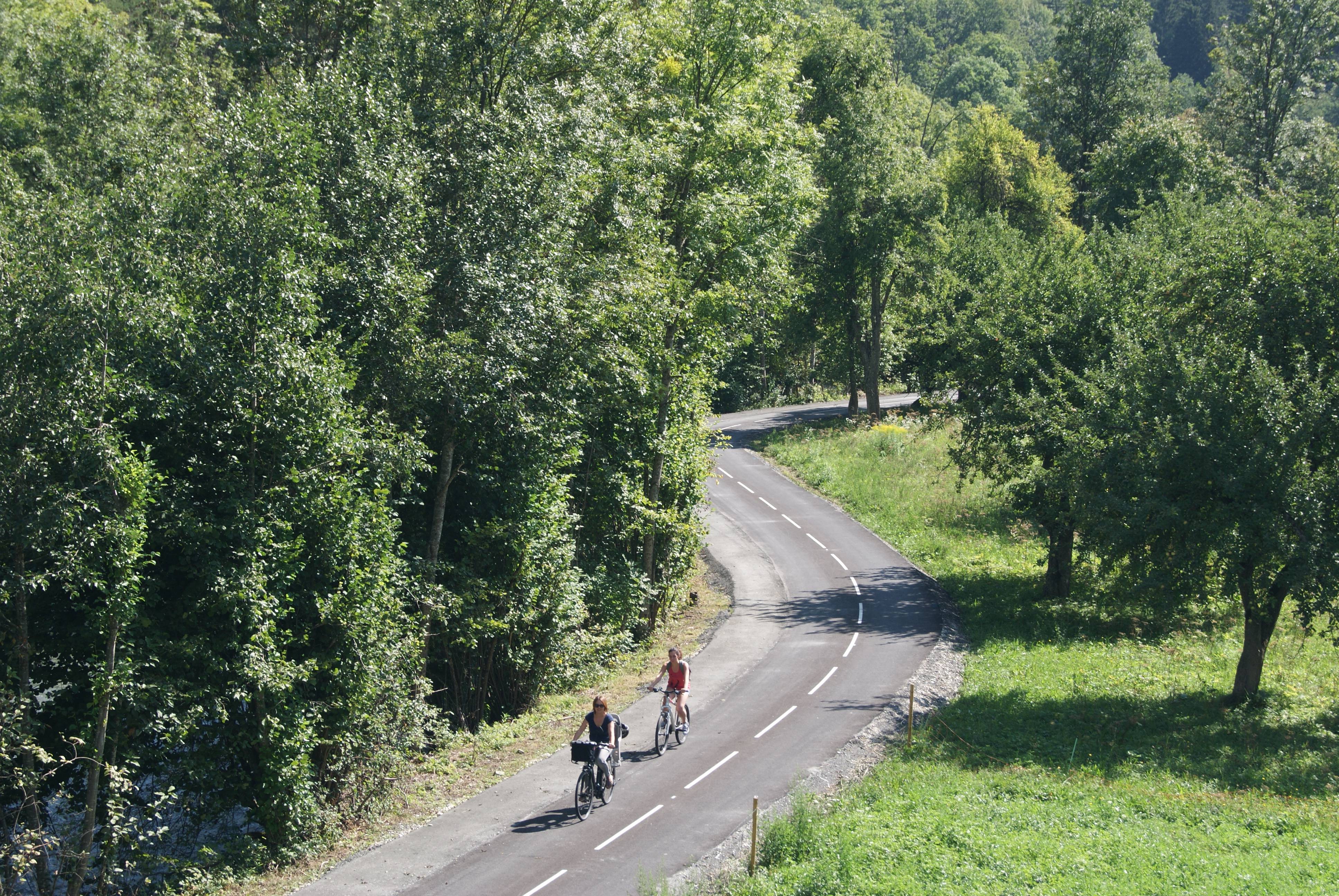
Along the River Isère between woodland and picturesque villages
Description
Follow the blue waymarks: Au fil de l'Isère.
E-bike rental shops:
GRAVITY LAB
297 Av. Marechal Leclerc
73700 Bourg Saint Maurice
+33 (0)4-79-40-05-54
Intersport Bourg Saint Maurice
Zone commerciale de Super U
73700 Bourg Saint Maurice
+33 (0)4 79 04 04 30
Laboshop Bourg Saint Maurice
avenue du stade
73700 Bourg-Saint-Maurice
+33 (0)4 79 07 07 61
PRECISION SKI Mountain Tribu
43 Place de la Gare
73700 Bourg Saint Maurice
+33 (0)4 58 14 04 44
- Departure : Place de la gare (in front of the station) - 73700 Bourg-Saint-Maurice Place de l'église (in front of the church)- 73210 Aime
- Arrival : Place de la gare (in front of the station) - 73700 Bourg-Saint-Maurice Place de l'église (in front of the church)- 73210 Aime
- Towns crossed : BOURG-SAINT-MAURICE, LANDRY, LA PLAGNE TARENTAISE, and AIME-LA-PLAGNE
Forecast
Altimetric profile
Recommandations
If in doubt, you can take an introductory lesson in how to ride an electric bike with an instructor.
If you see a herd ahead, slow down and go round it. If there is a patou, a guard dog, climb down from your bike and walk, pushing it alongside you. Avoid making any sudden or aggressive gestures towards the dog and move away from the herd slowly and calmly. The dog will only be checking that you do not pose a threat to its herd. Respect the parkland and close gates behind you after you've gone through them.
The mountain is living, please respect it by staying on the paths and tracks.
Information desks
Transport
Find out more at: www.oui.sncf.com
Have you also thought about car sharing.
Access and parking
Parking :
Accessibility
- Emergency number :
- 114
10 points of interest

Le pont des raves et la voie verte - CCHT  History
HistoryPont des Raves bridge (white water centre)
In the olden days, turnips used to be grown in the village of La Ravoire, and in 1850 there was such a bumper harvest that, to make a bit of money, one villager decided to go to the Bourg-Saint-Maurice market to sell his produce. A wooden footbridge over the River Isère had to be crossed, but this was so rickety that it collapsed under the weight of the heavy load. Thankfully the villager wasn't injured, but all of his cargo was lost, and the French word for turnips, raves, stuck.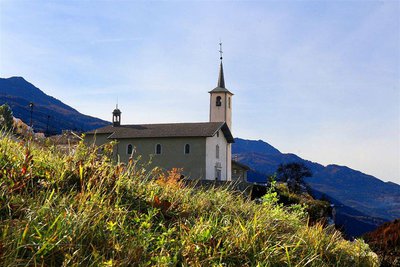
Eglise Saint Martin de Tours - Raja Bundhoo  Architecture
ArchitectureSaint-Martin de Tours Church
Rebuilt between 1681 and 1694, the church in Hauteville-Gondon, dedicated to St Martin of Tours, is decorated with colourful 17th century altarpieces. The high altar may be the handiwork of Valsesian sculptor Joseph-Marie Martel. The last restoration phase (which lasted more than 5 years) particularly saw the original colours being restored to one of the altarpieces, the painted décor of a draped cloth crowning the Rosary altarpiece (listed as a Historical Monument) refreshed, the 19th century painted décor of all of the vaulting restored and its original décor enhanced, including the strikingly colourful motifs in raised stucco on the keystones. Previously completely hidden from view, their restoration bestows special status on this church, since they are not found in any of the other Baroque churches in Savoie.
Guided tours and opening times: enquiries at the tourist offices of Bourg-Saint-Maurice / Les Arcs.
Village d'Hauteville-Godon - René Mugnier  History
HistoryHauteville-Gondon village
Located downstream of Bourg-Saint-Maurice, on the left bank of the River Isère, Hauteville-Gondon was an independent municipality until 1964. Its name perhaps comes from the Latin expression alta villa (meaning high estate), since the main town was built on a promontory particularly to protect itself if the Isère broke its banks.
The name Gondon, meanwhile, comes from a village, and was added to Hauteville at some unknown stage.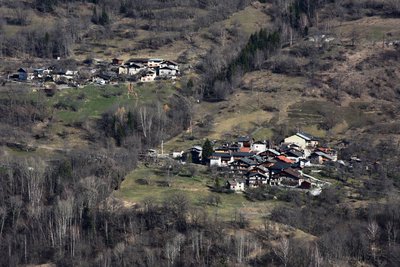
Village de la Chal - CCHT  History
HistoryVillage of La Chal
The village's name is believed to come from the Latin term calmis, which means meadow or pasture. With its local farmland, the village of La Chal is a striking example of how mountain hamlets long used to be organised. It is built upon a very small, sloping plot of land, giving precedence to farmland where multiple crops are grown alongside grazing livestock. The houses are almost all adjoining and built one above the other up steeply rising lanes.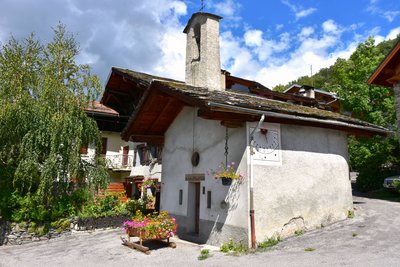
La chapelle Saint Grat - CCHT  Small heritage
Small heritageSt Grat's Chapel
Built in the mid 17th century, the chapel is dedicated to St Gratus, Bishop of Aosta, who is the patron saint of harvests. It does not have an altarpiece, but boasts a central painting featuring several patron saints. The chapel is often closed, but you can still glimpse the interior through two small windows.
Intérieur du musée de la pomme - EAC Aime  Know-how
Know-howMaison de la pomme
Find out all about the know-how that has been cultivated here around apples: from grafting to cider, in keeping with tradition, to perpetuate old orchards and varieties.
Free: enquiries in the tourist offices of Bourg-Saint-Maurice / Les Arcs.
Animation pour enfants sur le sentier des vergers - Jean-Yves Vallat  Know-how
Know-howA footpath worth getting your teeth into!
Between Grand Gondon and Landry, head out along the Sentier des vergers (orchards' trail), specifically between the Saint-Pantaléon and La Ballastière orchards. Fruit trees have been grown in Tarentaise for centuries, and the "meadow-orchard" tradition enabled a unique combination between fruit and livestock grazing. Apples and pears were grown near hamlets where the individual plots, with four or five trees in each, grouped together to form the patchwork "meadow-orchard" landscape where grass and fruit were nurtured side by side. The fruit was harvested in early October, before the cowherds and cows came back down from the highland pastures and montagnettes, small seasonal settlements. Once the cows were back, they could graze without the risk of choking on a fallen fruit. This system was also a natural way of fertilising the soil. The orchards were thus all planted in the open field with fairly high branches so as to allow the herds to roam around freely.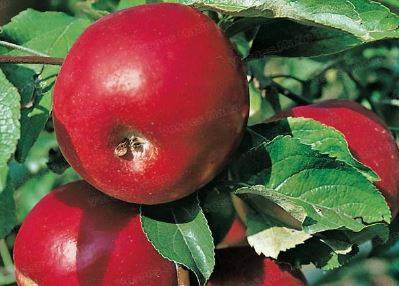
Variété de pomme - ADT de la Savoie  Know-how
Know-howLa Ballastière repository orchard
A new type of orchard well worth exploring and experiencing on a tour of this scenic complex, located on a hillock overlooking the River Isère. Easy 600m walk with explanatory panels (30 mins) telling you about the different stages in an orchard's life cycle. Picnic tables available.
With the help of the association "les croqueurs de pommes de Tarentaise Beaufortain", the municipality of Bourg-Saint-Maurice established this orchard to help safeguard a number of old fruit tree varieties in our region.
D.Dereani - Fondation Facim  History
HistorySt Nicolas' Church
The first records found of the parish of Macot date from 1096.
Its church underwent major repair work in 1475 and 1511. It was even completely rebuilt in 1676 by the same master builders who built Aime's church (labour and materials cost 2,700 florin coins).
Like other churches dating back to this time in Tarentaise, it comprises three naves and bays as well as a chancel with a rectangular chevet. The bell tower lost its top during the French Revolution in 1794, but was rebuilt in keeping with the original architecture: bulbous roof topped with two successive lanterns, each crowned with an onion-shaped dome.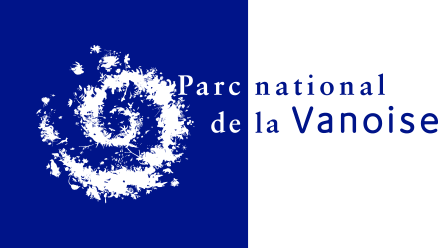
 Small heritage
Small heritageSt Sébastien's Chapel
This chapel dates back to 1628. It is believed to have been built thanks to the generosity of the village's prominent figures. It is often called "Chapelle de la Salette" after the statue of the Virgin of La Salette inside (donated by a village local). Notre-Dame de La Salette is how Catholics refer to the Virgin Mary when she apparently appeared before two children on 19 September 1846 above the village of La Salette-Fallavaux, near Corps, in the Isère département (just south of here).
St Sebastian, meanwhile, was called on to heal leprosy and plague, an outbreak of which ravaged the municipality. The great plague epidemic hit many households here, such that by 1348 there were only seven cottages left in Sangot that asked to join Macot. Since then, Macot and Sangot have formed the same municipality.
